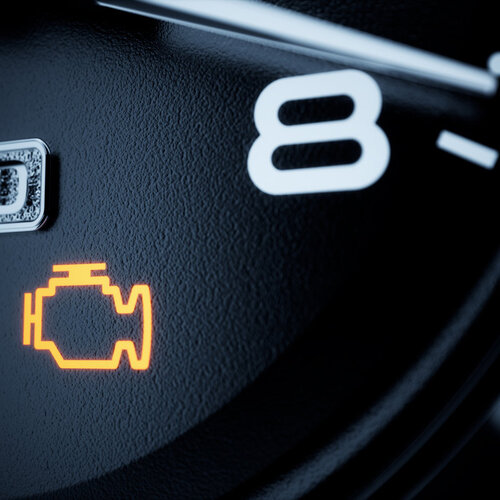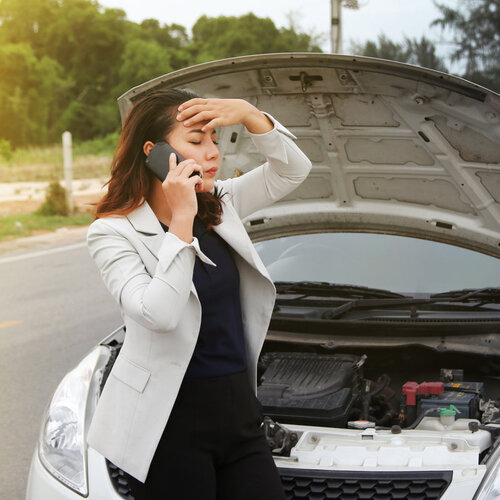
Diagnosing a Check Engine Light
Bright, colorful lights can be pretty, with a few exceptions, like a police car behind you, emergency vehicles in front of your home, and the check engine light on your car’s dashboard. These are typically not the bright, colorful lights you want to see. And when it comes to your car’s dashboard, this means your car needs a check engine light diagnostic service.
Is a check engine light always bad?
Not necessarily – the check engine light is a malfunction indicator lamp for the automotive industry. It is a signal from the engine’s computer telling you something is wrong. Sometimes a check engine light diagnostic will find the light came on simply because the gas cap was faulty. You can replace your gas cap as an easy way to see if the check engine light turns off.
But often, it does mean something is seriously wrong – like the engine misfiring. If replacing the gas cap doesn’t turn the light off, you’ll be left asking yourself, “Why is my check engine light on?”. Well, you’ll need to take your car to your mechanic or the dealership where they can perform a check engine light diagnostic test to answer that question.
What is the most common reason for a check engine light?
After the possibility of a faulty gas cap, here are five other common reasons a professional check engine light diagnostic testing may find your light is on:
- Dirty or Low Oil
Oil is needed to lubricate the engine components and reduce friction and wear & tear of those components. This allows them to run smoothly and protects them from damage. That oil also minimizes the heat that generates in an engine while driving.
Low oil pressure or dirty oil will cause the check engine light to illuminate because the oil isn’t getting where it needs to be. Have your oil changed immediately and see if that fixes the problem. If not, a check engine light diagnostic may find another one of these issues.
- Oxygen Sensor Failure
The oxygen sensor is in the exhaust system and measures the amount of oxygen in the exhaust gasses coming from the engine. This data goes to the onboard computer and determines if the air-to-fuel ratio is correct. If not, the oxygen sensor alerts the computer, and the check engine light comes on.
An oxygen sensor can fail when the contaminants like phosphorus and silicates get in the exhaust. This can happen when poor-quality fuel is used. If your car’s gas mileage is getting worse, the check engine light will come as well. A professional check engine light diagnostic test will tell a mechanic precisely the problem and it can usually be remedied.
- Catalytic Converter Failure
The catalytic converter cleans the exhaust emissions by converting the harmful compounds into safe gasses. When the converter becomes clogged by coolant and engine oil, it will send a signal to the computer and the check engine light illuminates.
The CEL will also come on when the catalytic converter overheats because of unburned gas or a faulty oxygen sensor. If you’re having trouble starting your car or accelerating, it could be that the catalytic converter is having issues.
- Spark Plugs
Spark plugs create an electrical spark that ignites the air and fuel mixture in the engine, resulting in the combustion that is needed for a car to start. When carbon, fuel, or oil deposits form on the spark plugs, the spark plugs become corroded. This causes them to misfire, which can lead to difficulties starting your car.
When your engine is hesitating at take-off, misfiring, or has a rattling or vibrating noise while idling, the CEL is likely coming on too. You should schedule a check engine light diagnostic test with your mechanic at this point. Changing the spark plugs will usually fix the problem.
- Air Flow Sensor Failed
The mass airflow sensor is part of the electronic fuel injection system. It calculates the amount of air getting to the engine, but if it is contaminated or damaged, it can’t measure the airflow correctly. Then the engine gets a wrong mixture of oxygen, and the check engine light comes on.
A professional check engine light diagnostic by your mechanic can determine this problem and make the appropriate adjustments or repairs needed.
Will a check engine light come on for transmission?
Yes – if your car is having transmission problems, the check engine light may come on. However, that problem is not as obvious as other issues and a professional check engine light diagnostic is needed to determine the exact problem.
Will a check engine light come on for low oil?
Absolutely, and this could be considered the number one problem after a check engine light diagnostic is done by mechanics. Keeping the oil checked on a regular basis and maintaining a schedule for changing the oil is a must for a car to keep running correctly.
Can I drive with the check engine light on?
Yes, for a short time. Once the CEL is illuminated, you need to schedule an appointment with your mechanic for a professional check engine light diagnostic test. It may be something as simple as a loose or faulty gas cap, but it can also be something more serious. The longer you drive with the CEL on, the higher the chance you may break down.
Every driver should know what to do when the check engine light comes on, and that is contact your mechanic immediately for an appointment. If the car is running badly and the CEL is on, pull over to a safe place and call a tow truck. Until a check engine light diagnostic is done, you should quit driving the car.

In Closing
Many think a computer can’t make mistakes, and many think they make them all the time. With that in mind, is there a computer in a car too? Can a check engine light be false? Yes, there could be some slight glitch that causes your CEL to illuminate. However, you won’t know that for sure until a check engine light diagnostic is done.
A professional mechanic will determine from that diagnostic testing what the problem may be and if there isn’t anything wrong, they know how to reset your check engine light so that it isn’t on all the time. If it comes back on, you should return to the mechanic for another diagnostic check.